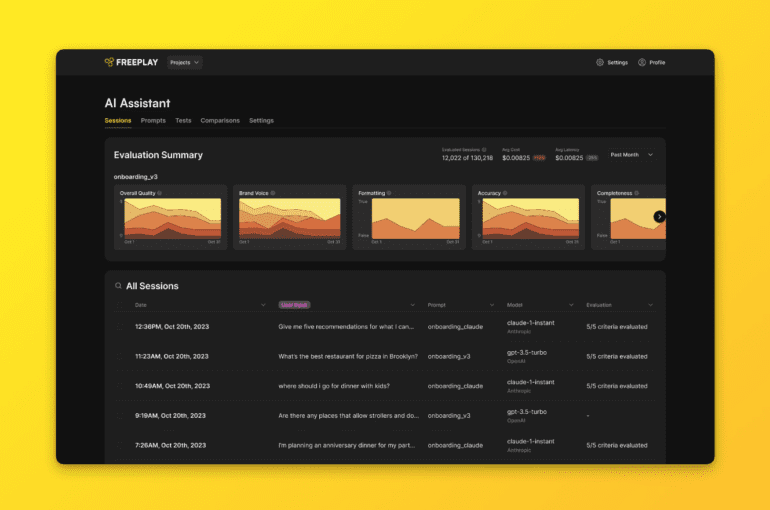TL;DR:
- Freeplay, a startup led by ex-Twitter employees, has secured $3.25 million in a seed round led by Conviction Ventures.
- The company empowers product development teams to build, experiment with, and test AI-powered apps using generative AI models.
- Freeplay’s platform offers observability tools, beginner-friendly features, and custom evaluation tools for LLMs (Large Language Models).
- It stands out by providing an end-to-end toolset suitable for cross-functional teams, bridging the gap between prototype and production.
- Early success is evident, with customers investing significantly in its services.
- Freeplay plans to expand its workforce and bring its core product to market.
Main AI News:
In the dynamic world of technology, innovation is the driving force behind every successful venture. Freeplay, a groundbreaking startup founded by ex-Twitter employees, is set to revolutionize the landscape of AI-powered applications. With a fresh infusion of $3.25 million in a seed round led by Conviction Ventures, Freeplay is ready to empower companies to build, experiment with, and test applications driven by generative AI models, specifically text-generating models.
Founded by industry veterans, including the former heads of product and engineering for Twitter’s developer platform and enterprise data business, Freeplay is on a mission to provide product development teams with the tools they need to prototype and enhance software features powered by large language models—models that are akin to ChatGPT or Meta’s Llama 2.
Ian Caims, co-founder and CEO of Freeplay, emphasizes the importance of their mission: “For seasoned product development teams who might be new to AI, we provide a tool suite that helps them adopt best practices. Freeplay gives these teams the confidence to integrate LLMs into their products and ultimately deliver better customer experiences.”
Cairns and Eric Ryan, co-founders of Freeplay, draw upon their extensive experience gained at Gnip, a social media API aggregation company, which was acquired by Twitter in 2014. After the acquisition, Caims led the developer platform, and Ryan was the senior director of engineering at Twitter’s Boulder office. Their collaboration at Gnip ignited the spark that led to the creation of Freeplay.
The inspiration behind Freeplay stemmed from the challenges they observed enterprises facing when embracing Large Language Models (LLMs). Existing observability tools struggled to track LLM outputs at scale, and experimentation practices were lagging behind the rapidly evolving generative AI field. Caims elaborates, “We were seeing how transformative LLMs would become as the technology moved from the research space to production use. In particular, many of the business-to-business software-as-a-service companies we’d worked with for years had never built with machine learning technology before, and we saw the need for new tools and new development practices to help those types of companies adopt LLMs and then improve over time.”
Freeplay’s platform seamlessly integrates developer tools with a web-based dashboard. From the dashboard, teams can monitor how users interact with an AI-powered app, track metrics such as estimated costs associated with running the app, and assess the app’s average latency.
But Freeplay offers much more than observability. It provides beginner-friendly features that enable users to experiment with different prompts for LLMs and easily switch between models from different vendors, such as OpenAI and Anthropic, in live software. Additionally, Freeplay offers tools to facilitate the identification and implementation of custom evaluations of LLMs, utilizing “auto-evaluators” (automated testing tools powered by LLMs) combined with human labeling workflows.
Caims explains, “We help customers build a feedback loop to optimize their LLM evaluations. For example, accountants might need to review outputs for an AI accounting feature, or doctors and scientists might need to review outputs for biotech or healthcare applications. This helps companies build a high-quality dataset that becomes an asset to further optimize the customer experience and cut costs, including by fine-tuning LLMs.”
What sets Freeplay apart from the growing collection of tools on the market for building and benchmarking AI-powered apps? While there are generative-AI-focused observability platforms like Helicone and platforms for tracking and sharing prompts, such as PromptLayer and LangSmith, Caims argues that most vendors focus on a “narrow slice of functionality” and target individual developers. In contrast, Freeplay’s end-to-end toolset is designed to meet the needs of cross-functional teams at larger companies, providing them with the control they need to take their projects from prototype to production confidently.
Freeplay has already achieved early success, with early customers investing “several hundred” to “several thousands” of dollars a month in its early service. With the financial backing from the seed round, Freeplay plans to expand its 10-person workforce to around 25 by the end of the year and bring its core product to market, setting the stage for a new era of AI-powered application development.
Conclusion:
Freeplay’s emergence and success underscore the growing demand for accessible tools that enable businesses to harness the potential of AI-powered applications. The platform’s comprehensive approach to bridging the gap between prototype and production positions it as a game-changer in the AI app development market, catering to both experienced developers and cross-functional teams. This development reflects the increasing importance of AI in various industries and the need for user-friendly solutions that drive innovation and enhance customer experiences.

